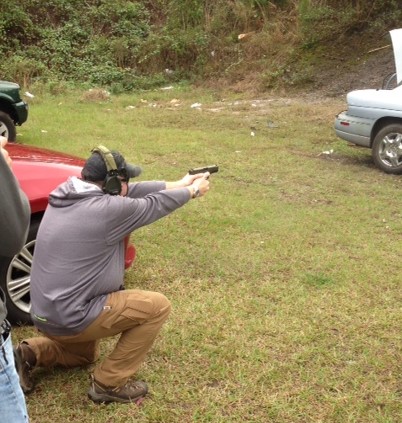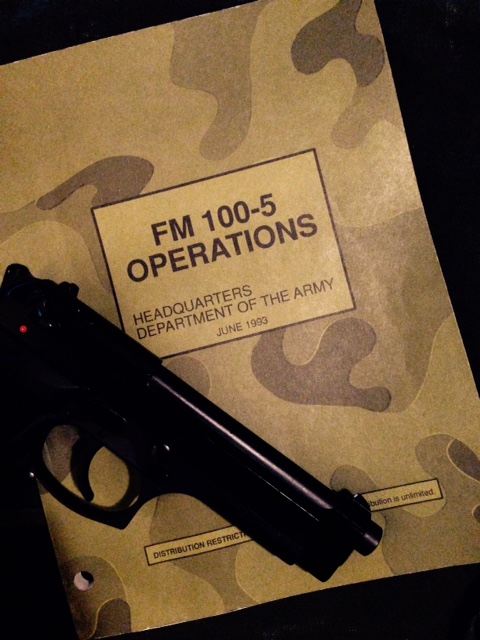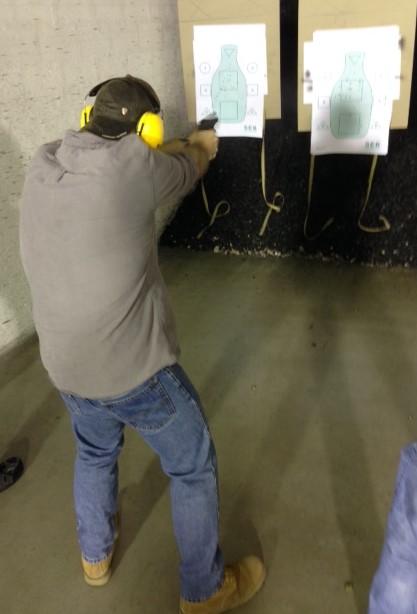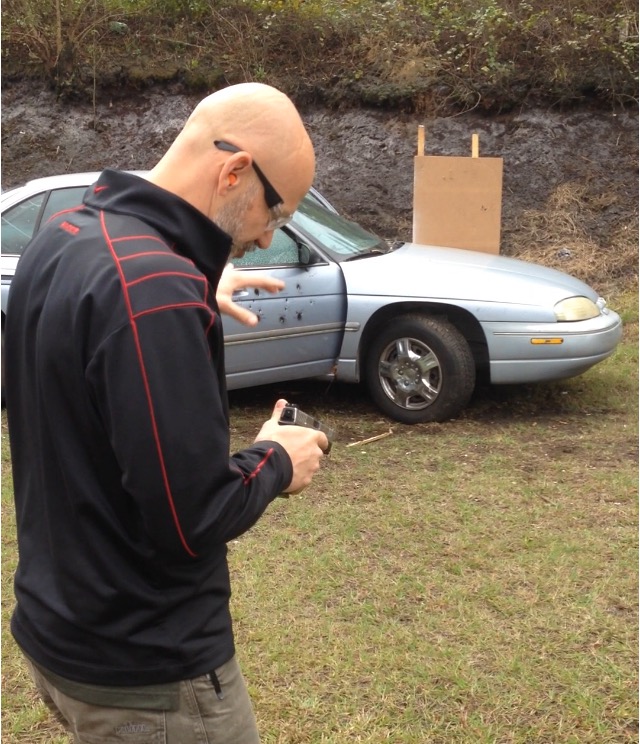
Use of cover is a straightforward individual skill that becomes more complicated in a crowded public space. Planning and training as a team are essential. Photo: author
In my case, those lenses are OD Green in color, causing me to first see everything around me as influenced by my military background. This is important, because as someone who has taught soldiers and now teaches armed private citizens, I have to be sharply aware of the vast difference between the two. Context is the key to how much value any training is going to have. Those who are never going to kick a door don’t benefit much from Doorkicker School. Conversely, those who work with carbines strapped across their armored chest rigs won’t find presentation from concealment on their Top Three skill-set list.
Because of this, it really stands out to me when I do run across an idea or concept that bridges this gap and is equally applicable to military combat operations and day-to-day self-defense for the average concealed-carry permit holder. I recently attended a training course that clearly demonstrated such a parallel. Afterward, I was inspired to dust off a couple of old Army manuals and see how their long-ago lessons are still useful to (retired old soldier guy) me today.

1993 copy of FM 100-5, “Operations”. Its most important lesson is about coordinating the actions of all available assets. This is an easily overlooked part of our personal defense training. Photo: author
Force Projection
The class was I.C.E. Training Company’s Two-Person Armed Defense course, and it brought vividly to mind concepts I had first encountered in FM 100-5 Operations, among other military publications.
First is the idea of Force Projection. This is what most people envision – and I would define for simplicity’s sake – as the “activity of war.” A tank maneuvering into position, an artillery piece firing, or the soldier aiming and shooting his rifle. The collective ability of the resources brought to bear in combat are part of Force Projection. In citizen self-defense, this is both how well I operate my pistol and how many others, such as my wife, will be operating pistols alongside me.
Force Protection
The more important concept – and the one that mirrors what was covered in the Two-Person Armed Defense course – is that of Force Protection. In short, this is Army-speak for the things that can be done to prepare for unknown threats or natural disasters on or off the battlefield. Sounds a lot like what you and I, as lawfully armed citizens, might consider prior to a trip to the mall, doesn’t it?
Force Protection recognizes that it is important to account for and manage known risks. Things such as weather and terrain need to be addressed, and they’re important no matter if you’re storming a beachhead or going Christmas shopping at the local mall. The weather influences how you dress, and terrain becomes where you’ll park your car. So the first lesson of Force Protection is to plan ahead. This is likely not news to you if you’re a regular here, but it may be interesting to note that what you do (or should be doing) in the name of personal security is identical in concept to what the Army does to arrive on the battlefield in one piece. In fact, if your planning skills are as disorganized as mine, you can even borrow the military method for not forgetting the important stuff: it’s called METT-T. It stands for Mission, Enemy, Troops, Terrain and Weather, and Time available. While an imperfect model for our purposes, it can serve if translated like this:
MISSION: Shopping trip to local mall.
ENEMY: Likely present, but strength and configuration unknown.
TROOPS: Myself, armed with a concealed handgun. My wife, also armed.
TERRAIN and WEATHER: Mid-December in Ohio, requires coat. Movement from remote, unsecured parking lot to large, crowded indoor space.
TIME AVAILABLE: Usually not a life-or-death consideration at the local mall, but what the heck. You could, for instance, plan to be done before sundown to avoid a dark parking lot.

Good teamwork requires good individual skills.
Photo: author
The second phase of the plan is the actions taken in the event of an emergency. This is where the military model best fits into the context of private citizen self-defense. It is easy for most of us to focus solely on our individual skills – of course, I need to be able to do those basic “carry and shoot my gun” things. But now, we’re not talking about just me defending just myself. We’re looking at a situation where I am acting in concert with others, in support of a collective defense. The word we’re looking for here is teamwork – and successful teamwork is the result of planning and training.
Teamwork and Coordination
Not surprisingly, the military excels at teamwork. No battle plan can ever rely on the performance of a lone soldier, and your plan for your family to survive a mass shooting event in the mall food court cannot be predicated on your gun skills alone. Participants need to know where they are in relation to both the threat and each other, what they are doing, and where they are going. This requires planning, training, and practice.

A good next step is to bring individual skills into more realistic complex environments, where good planning and teamwork are most needed. Photo: author
Communication
Another key to success is communication. During an incident, we need to know what’s going on with the other members of our group and to let them know what’s going on with us. The chaotic, fluid nature of something like a spree shooting event makes that very difficult. But that difficulty can be eased by planning. For example, parents can use a known code word that tells their kids to “get behind me” if it looks like things might get ugly. The military swears by the use of such SOP (Standard Operating Procedure) roles, and they are of huge value for streamlining communications.
The military combat context and the citizen self-defense context usually don’t interchange much. After all, the soldier in a danger area has both a high expectation of violence and a coordinated, collective response to it. Military combat training also involves the nearly unlimited resources to work shoulder-to-shoulder as a team of several or a division of thousands. The citizen lacks both the foreknowledge of the fight and the resources to train for it in elaborate detail. But this doesn’t mean that we private citizens can’t absorb the lessons of training as a team for emergency response. We can take the concepts of that training – Force Protection is the conditions under which we plan, and Force Projection is the weapons, skills, and comrades we bring to the fight – and apply them to the everyday reality in which we live.
As a retired soldier, the ideas of METT-T, SOPs, and Force Protection/Force Projection work for me because they’re familiar constructs that I have already absorbed and employed. However, it took my attending the excellent I.C.E. Training Company’s Two-Person Armed Defense course for me to adapt them to my family defensive strategy. I strongly encourage anyone who is already training for emergency preparedness or self-defense to include this must-have course in their plans.
Yes! Plus many other military training benefits: Time, Skills, Experience AND Discipline.......though in the civilian world it may be better to call this "Attitude to Cooperation". Civilians tend to think as individuals, not as a team. "Discipline" is kind of a bad word amongst all our freedoms. Kind of like "herding cats". This means we are often "shooting ourselves in the foot". A little bit of the Staff Sergeant approach would help our competence immensely.............
Don't over look over looking the possibility of having to coronate actions with unknown good guys in an extreme situation. This was a very interesting article, Thanks
Back in the day, we called it mission threat assessment, in the oil field we call it a JSA.. when Murphys Law doesn't pop in, great article thanks
Andy, Great essay! Kenn Lewis
I was never in the military but got my clock cleaned by two on leave soldiers in a paintball game. Lesson learned. From then on the guys (team mates) I played with incorporated the lessons we learned. Paintball is a great teaching tool. The field is so dynamic and fast. Makes one learn to keep both eyes open, assess, assess, assess and move, move, move. Ageing knees has taken it’s toll on me so those days are done, but the lesson we’re learned. Thanks for the perspective. I don’t like malls and the ones around here don’t allow CCW. We seldom go there.
I see this is an article is almost a year old - which doesn't reduce its value - but it was just sent to me as an attachment to a Personal Defense Network training video. I may be too late to get any feedback, but, it raises a question. My wife also has her Concealed Carry License (Yes, in Florida it is called a license, not a permit); she usually does not carry when we go out. She says, "You're carrying; I don't need to. Besides, I don't have pants with belts to carry my gun." I try not to nag about it; but, when the subject comes up, I often comment that "If we're both carrying, our chances of prevailing in an encounter is about four times better." I don't have any sources to back up that statement; but, it seems logical to me (YMMV) that the advantage of multiple defenders is not just a straight linear progression. Does anyone have any source material that provides an analysis of the advantage of having multiple armed defenders in a civilian armed encounter? Obviously, tactics are much different if there are two of us, both armed; than if there are two of us with only me armed. Also obvious, is that any discussion of this difference is going to be better received if it comes from someone other than me!
I like the caution word to use with your family ASAP to get behind mom or Dad. I am pretty aware of our surrounds when we are out in public.I didn"t think that we needed a pass word. We learn something every day. Thank You. The Stewart family.
I hate to be the "turd in a punch bowl" but my family members are NOT "Brothers in Uniform", nor am I going to put them in harms way. First off, if the mall in question is that dangerous, as in we do not want to be there after dark, then we don't need to go there in the first place... that is why God made the internet (joke) Moving on, my family has a plan, the plan is simple, when danger is present they retreat to the family car. All of my family are licensed concealed carry individuals and I would bet that they spend more time on the range than the average street cop. Last month we burned over a 1,000 rounds. Everyone of my family is a "marksman", under Military classification. The best plan in my humble opinion is to "communicate the facts" before they happen. Meaning, you hear gun shots, you leave, you see fighting or a group rioting, you leave, you see a gun under a coat, you leave. There is only ONE person in my family that has had the training to run into the burning building. My family sticks together, therefore, if one leaves they all leave. It is sad that our society has deteriorated to this line of thought, but it is what it is. I applaud and thank you for service to our great country, but "combat hand signals" to family members...really? My thought is simple, plan and agree on an evacuation scenario in the safety of your living room.
Concur with everyone else here that this was a very good article. Very enlightening and it reinforces (and introduces) the use of military acronyms for activities of daily living. I do use METT-TC as well as OCOKA when traveling. Please do more of these since I'm sure that everyone finds it helpful, educational and a fun read.
Would love to have more information on this subject!